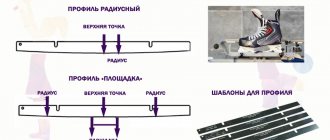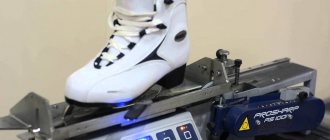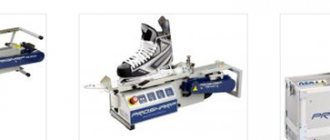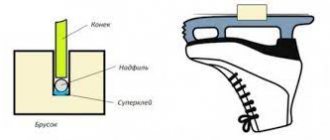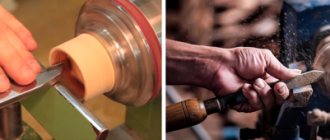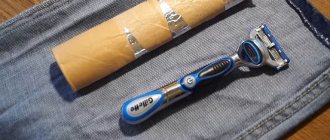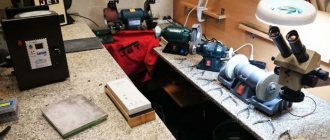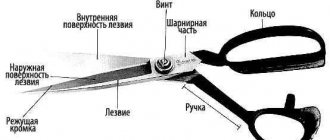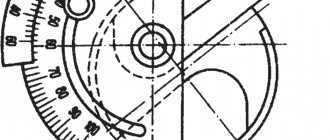If you need to sharpen your ice hockey skates, the groove size chart will be the best help for beginners to make a choice. However, if this process occurs at home, you need to know a little more about its specifics, since improper sharpening can lead to overheating of the metal, which in turn will affect the imbalance of the blade.
Many professional hockey players know how to sharpen skates specifically for their skating style, because the type of sharpening is chosen precisely according to this criterion. First of all, it is important to know the person’s weight, his position in the game - attacker or defender, how long he has been skating and how confident he is in his movements.
You should sharpen your skate blades if:
- a new pair was purchased and there is no groove on the blades;
- when turning, the blades move to the sides;
- During acceleration, slipping is felt.
It is best to sharpen hockey skates if any discomfort occurs while skating. Experts advise not to grind off a large layer of steel, but to carry out the sharpening itself regularly. After this process, hockey players balance better on the ice and can control their actions during the game, the skates glide faster, do not get confused or move to the sides, they can quickly accelerate and make sharp rotations.
Types of sharpening hockey skates
For beginners, it is best to contact a specialist who can determine how deep the steel of the blades has already been cut, what type of sharpening to choose and how to properly care for the uniform in the future. Hockey blades can be processed, just like figure skates can be sharpened, in sports stores, ice complexes, or from individual specialists.
It should be immediately noted that the new skates do not have threads on the blades - their profile is completely straight. Therefore, professional hockey players, after purchasing ice equipment, immediately sharpen the blades to suit their skating style. Basically, figure skaters use a standard type of sharpening, while hockey players are offered a little more options. In Russia, mainly only two types of sharpening hockey skates are used, but in total three of them can be distinguished.
Classic or groove sharpening is a more common method; it is used by everyone who skates on ice: figure skaters, speed skaters, hockey players. The standard type of sharpening is considered the most reliable and proven. Its essence is that a semicircular groove is made on the blade. The blade of the skate has two ridges on the sides and a groove inside. The presence of ribs on the blade gives much stronger grip on ice than a completely straight axle.
The depth of the groove, which is suitable for sharpening the skates of a particular hockey player, is determined depending on his style of skating and play. Typically, when sharpening ice hockey skates, players use a table with specific groove parameters.
If the groove radius is small, then driving speed increases, but maneuverability decreases. Accordingly, if you choose a deep groove, then the skate’s controllability during turns and various techniques becomes better, but in the case of straight skating on ice, the speed becomes lower.
Channel-Z, or groove-zed, is a relatively new type of sharpening in Russia. It is used by many professionals, since a sharpened Channel-Z skate is more controllable and at the same time can glide very quickly. Its profile looks like a small groove in the blade with another internal recess.
In this case, the width of the internal recess in the groove can be different. If it is large, then the driving speed increases, if it is small, control becomes better. This type of sharpening is performed only on professional equipment.
FTB (Flat Bottom V) is not carried out everywhere and only if you have an American or Canadian machine, since this type was developed in Western countries and is used by NHL teams. The profile of the blade when sharpened in this way looks like two sharpened ribs and a groove with a small straight platform inside.
When sharpening FTB blades, hockey players usually rely on high-speed driving in the game, but at the same time, a high level of grip on the ice is important to them. Experts believe that if hockey players often participate in games on artificial ice, then it is better for them to focus on high maneuverability rather than speed.
sportotip.ru
Two ways to sharpen at home
The process of sharpening blades requires a lot of effort and knowledge. At the same time, you can’t do this without special tools. As a rule, a professional skate sharpener uses finishing and polishing stones, a diamond abrasive stone, and a special automatic machine.
How to properly lace hockey and figure skates
Sharpening skates at home can be done in two ways, but they also require special equipment:
- Using a file is the easiest, but most labor-intensive way to sharpen skates at home. Round needle file of a certain diameter in accordance with table. 1 must be inserted into a block of wood with a U-shaped groove. The skate is secured in a vice, the prepared block is installed on the front of the blade, and the necessary contours of the hole are determined. In this way, the skates are sharpened by pressing hard on the blades. After this, be sure to remove all burrs with a flat needle file or a file with a fine notch.
- Using a grinding wheel is a faster way to sharpen skates at home, but requires special equipment. The grinding wheel should be 0.5-1 mm narrower than the radius of the groove. The grinding wheel must be installed on the drill, and the skate blade must be secured with clamps to a steel angle. After this, it is necessary to determine the contours of the groove. Further sharpening occurs from the front of the blade.
To make sharpened skates last longer, it is enough to wipe the blades with a dry cloth after each use and, when moving outside the ice surface, put special rubber covers on them.
Hockey skate sharpening
Dependence of the depth of the groove on the player’s parameters
The most common type, and, obviously, the most suitable, unless you are, of course, a professional, is standard sharpening. The groove of the blade is formed inward in a semicircle. The channel turns out to be round. Sharpening is carried out on machines, manual and automatic. It is worth paying attention to ensure that the dimensions of the groove correspond to certain parameters:
- skating rink surface – ice from a street skating rink or indoor skating rink;
- the hockey player’s position in the game – attacker or defender;
- player weight.
Classic profile
The radius longitudinal profile is measured by the radius in feet. For example: 14″ designation means the radius of the profile template is 14 feet. Used for profiling the blades of hockey skates: children's, beginner hockey players and amateurs. Sharpening is done on machines according to factory patterns with a sharpening radius from 7″ to 30″.
The most popular single profile patterns for children's skates:
- 11″ - for small players with good skating skills;
- 15″ - for young beginners;
- 17″ - for beginner young players with a lot of weight.
Benefits of sharpened skates
Properly prepared skates have a number of advantages:
Provides improved balance and better ride control. The legs do not slip, it is easier to balance and maintain balance when turning;
Reduced friction, improved sliding quality. The friction force is less, therefore less effort is spent on skating;
Maneuverability and acceleration. You can play more aggressively, good grip on the surface provides acceptable maneuverability, you can push off harder without the risk of slipping, and accordingly the acceleration becomes sharper.
Let's secure the information
Choose a sharpening for yourself, taking into account the characteristics of each technique. Modern requirements for sharpening skates tend to move towards European regulations. The main task is to reduce friction and effectively ride without losing speed.
Remember the basic rules for blade care to keep your edge sharp longer. Do not wear skates on hard surfaces without protective covers. Clean your blades after skating on ice. Contact a sharpening specialist regularly; do not allow the blade to wear out completely. Over time, blades lose gliding speed, resulting in poor preparation or performance on the ice.
Proper sharpening of skates
To prepare skates for skating, it is recommended to turn to professionals; it is advisable that they not only know the technical part, but also know the subject themselves and have an idea about skating on ice.
To do everything properly, first of all, you need to avoid the most common mistakes when sharpening:
- uneven steel removal. A very dangerous mistake that leads to imbalance of the skate.
- in artisanal conditions, there may be a difference between the outer and inner sides of the blades. This is a serious defect that can lead to loss of balance when skating;
- incorrect groove parameters or blade profile. Reduces the quality of skating and controllability when moving.
You should not sharpen them at home; you can damage your skates and make them potentially dangerous for the player; you should contact special workshops; this is the only way you will get blades of the required quality.
buduactiv.ru
This article is dedicated to sharpening skates. I want to talk about the types, pros and cons of sharpening and draw specific conclusions.
Let's consider the concept of “sharpening skates.” This is the most important thing to start with before going on the ice. The question immediately arises: Where can I sharpen my skates reliably? Our contacts and address are listed on the website.
You need to decide on the groove, the platform, and whether the skate profile needs to be ground down. Or set the technological tilt to two degrees. Which is very convenient when starting out. A quick increase in speed due to the tilt and the correct choice of site is guaranteed. This is determined by an experienced master. He asks, as many people think, unnecessary and incomprehensible questions about how much you weigh, where you skate (on offense or defense), and what kind of skating experience you have. And only then does he draw conclusions and determine how to sharpen your skates. There are many nuances about this. Therefore, we coordinate further work with you.
I'll start with the most common and widespread sharpening, both in Russia and around the world.
1. Radial (standard) sharpening of skates. This is when the groove of the blade is sharpened in a semicircle inward. Has a rounded channel.
The groove has two sharp walls and between them a radius with a gradation from 6 to 40. The depth of the groove is selected individually, you will read about this below. But we created a table for selecting a groove, where we used data such as the player’s weight, experience and role Table for selecting a groove.
2. Channel - Z - unique sharpening. The uniqueness of this sharpening is determined by the fact that it also has a groove, as in the first version, as well as another groove with a square channel in the middle of the usual groove.
Channel - Z has its own gradation of proportionality. Its depth varies from 0.8 to 2 mm, as well as the width of the channel. The Z channel has three widths: S, M, L. Read more about Z sharpening below. To know the exact width of the blades down to hundredths of a mm, you need a micrometer.
3. The FBV sharpening is a very old Canadian development, used for over 20 years in North America. Many teams in the NHL use it. Most players really like it. Of course, there are also negative reviews. This type of sharpening has a good efficiency factor. Efficiency - good rolling plus good grip on ice and minimal effort.
FBV (Flat Bottom V) - this type of sharpening is not very common in Russia and Europe. Only quite recently has this sharpening begun to spread in our country.
The groove is unique. If the standard sharpening has a round channel in the form of a semicircle, then in this case the FBV sharpening has a trapezoidal channel.
This is when a channel is sharpened from the inner plane of the groove to the walls of the blade along a trapezoid. Here we must pay tribute to the internal part of the channel - it is a rigid landing and good stability. And the plane creates stability. The trapezoid provides a more rigid grip on ice than the radius chute. On good ice of indoor palaces, sharpening lasts an average of 12 hours.
About Radius sharpening (standard) The standard channel is sharpened on machines, both manual SSM and the like, and automatic ones like PROSHARP and SHARPMASTER. They are the most common and time-tested in practice. Their reliability is not even discussed. The main thing here is that the depth of the groove corresponds to the weight and some other specific properties of the athlete. Properties of an athlete. Firstly , before sharpening, the master determines where the person will skate (on the hard ice of a street skating rink or on the artificial indoor ice palace).
Secondly , if a person plays hockey, then his role is determined, i.e. location in the game (on offense or defense).
Thirdly , the player’s weight is specified. This is one of the main questions when selecting a groove. The master must also determine the current area of contact with the ice. Based on these data, a groove is selected. There is one more property, but it applies to figure skaters. Here the skating is specified - with or without jumps. Fourthly , the riding style, aggressive or tactical, is specified; these properties are also important when choosing sites and profiles. Learn about profiling below.
About the groove The groove consists of the tip of two walls. These walls after sharpening should be equal to 90 degrees. If one of the walls is lower than the other, then you will fall in the direction with the lower wall. Also, the tip of the blade must be sharpened over the entire surface. If you see any reflection similar to the previous sharpening color, then the blade is not completely sharpened.
pro-tochka.ru
Flat Bottom V (FBV)
The latest trapezoidal sharpening type developed over 20 years ago in North America. It is considered the most effective in terms of efficiency of all listed types. Actively used by hockey players in the NHL.
It is turned only on professional BLACKSTONE and BLADEMASTER machines, which creates difficulties for hockey players in Russia. The companies are not represented on the Russian market; you will have to pay dearly for replacing elements or new sharpening.
The essence of FBV sharpening lies in the peculiar shape of the groove. The channel in the inner plane of the blade is sharpened along a trapezoid. Due to this, a more rigid grip on ice is created, but ease of sliding is maintained. Sharp edges give the skates stability for maneuvers.
It is worth noting that in addition to the price, there is an equally significant disadvantage - the blade grinds off faster with this type of sharpening. Despite this, FBV has recently been gaining popularity in Russia among hockey players.
Do I need to sharpen new skates I just bought?
Do I need to sharpen new skates? Of course it is necessary, because many models have untreated blades. However, there are exceptions to this rule: Reebok manufacturers produce models with T-Blade blades. Such models have a mount made of hard material, on the edges of which small blades are installed, for the manufacture of which hardened steel is used. The durability of this material helps these blades stay sharp for up to twice as long as their counterparts.
Tip: If you notice that the edge is dull, replace the old blade with a new one.
How often should you sharpen your skates?
Another important question is how often to sharpen your skates. If you train four times a week, you should sharpen your skates twice a week. Many beginners ask why they need to sharpen skates. Below are four reasons:
- Skating on ice, a person will feel confident and enjoy skating.
- If the skates are sharpened, it will be easier for the athlete to control their balance.
- Sharpened skates provide instant acceleration, which makes it easier for figure skaters to spin and helps hockey players catch the puck faster.
- The sharpened blade improves gliding quality.
How to avoid mistakes
A common misconception is that any skates can be sharpened like kitchen knives, leaving only one sharp edge. This method completely deprives the athlete of stability, worsening the grip on ice, which is provided by a special groove (groove) on the blade.
Under the influence of friction of two planes of the blade formed by the groove, the ice melts - and a thin layer of water is formed in the groove, which improves gliding. Moreover, thanks to the groove, friction increases.
- The appropriate groove depth for figure skating is 5-6 millimeters.
- If skates are part of hockey equipment - 20 mm.
- For speed skaters – up to 45 mm.
Skates without grooves are suitable only for extreme sports enthusiasts who perform feints on ice, or for lovers of leisurely recreational skating who stand very confidently on their skates. In other cases, turning with a groove is necessary so as not to increase the risk of injury.
Since sharpening skates at home is a rather difficult procedure, it should not be carried out unless there is a real need.
Signs that turning is necessary:
- The groove is missing, although it is needed, or is covered with rust, or its structure is damaged;
- When turning, the blades move to the side;
- When pushing off, the runners slip.
If, for example, burrs have simply formed on the blades, sanding with emery or a fine-grained file is sufficient.
It is recommended that the first sharpening of new skates specifically for an amateur athlete be ordered by professionals. Especially hockey ones, because the specialist will take into account the hockey player’s weight, position (forward, defenseman or goalkeeper), and skating style. In a city where there is an ice arena, there will also be a grinder with special equipment; the price can be negotiated - bargaining is appropriate here. In other cases, independence is fully justified.
What properly sharpened skates look like
What do sharpened skates look like, and can you tell if they have been sharpened? Here's an easy way to check: Run your fingers along the blade - the edges should be sharp. Next, run the tip of your nail along both sides of the blades: scratches remaining on the nails are a sign that the skates have been sharpened correctly. Here's another way - if you look in profile, you can see that the surface of the blades on conventional models resembles a small groove with sharp edges. There should be uniform levels along the entire length of such ribs. Chipping on the edge is a sign of low-quality steel, so avoid purchasing such skates. To perform another test, put on your skates, stand on the ice and perform a side shift - your feet should not slide while doing this. Also perform a skating move - while making sure that your legs do not move apart.
Important! Don’t rush to sharpen your skates right away—it’s often enough to simply remove burrs using a diamond wheel.
Sharpening figure skates
Here are some common mistakes made when sharpening by non-professionals:
- When sharpening in an artisanal way, the sides of the blades turn out to be unequal. As a result, when skating, a person loses his balance.
- Also, beginners who do not know how to sharpen figure skates incorrectly remove steel from various parts of the blades. For example, they remove a lot of steel in the toe area. The result is imbalance and lack of support for the blade on the ice.
Important! Also remember that the quality of the ride will deteriorate due to the incorrect radius of the groove. The unit of measurement for this value is inch. This value shows the recommended sharpening radius. The radius of the groove affects the correct sliding and comfort when exiting jumps. The radius of the gutter is selected individually for skaters.
Sharpening hockey skates
When it comes to how to sharpen hockey skates, the most important thing is choosing the right type of sharpening. Here are some options:
- With standard hockey sharpening, the grooves of the blade are sharpened in a semicircle. There are also rounded channels.
- The peculiarity of channel z sharpening is the presence of a groove with square channels in the center.
- The least common type of sharpening is FTB. It is sharpened only on Blackstone machines. This type of sharpening is not common in the CIS countries.
Also, when wondering how to sharpen hockey skates, users should remember that skates with a standard channel are sharpened not only on manual, but also on automatic machines. This method of sharpening is the most reliable. Using Z sharpening, you can solve the problem with slippage. It also helps sharpen deeper grooves than conventional sharpening. This type of groove has been tested on European athletes for a long time, and it has been proven that it is superior to standard grooves in all respects. Among the advantages of FTB sharpening, it is worth highlighting its high efficiency, which is defined as follows: a small loss of speed and excellent grinding. However, this sharpening has its drawbacks - it is inconvenient to use a machine made by Blackstone. The fact is that to sharpen different grooves it is necessary to change heads and adjust the machines. This takes a lot of time.
Tip: To get a higher rolling speed, use grooves of different radii. Don't forget that different sharpening points are used for different riding styles.
So, sharpening figure or hockey skates is very simple - the main thing is to follow the advice given in this article. Happy skating!
helperlife.ru
